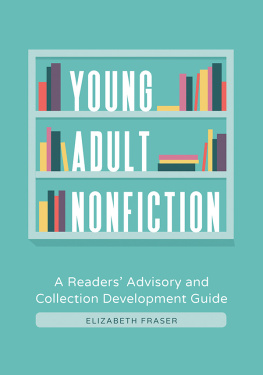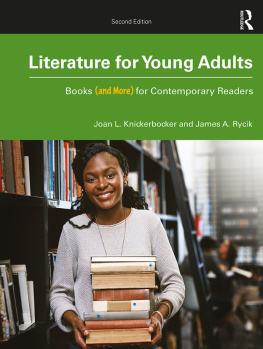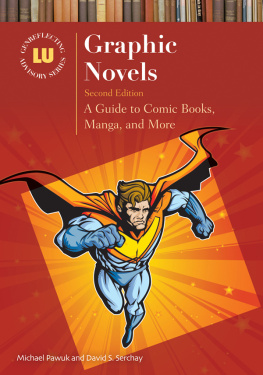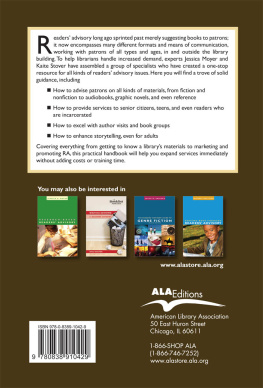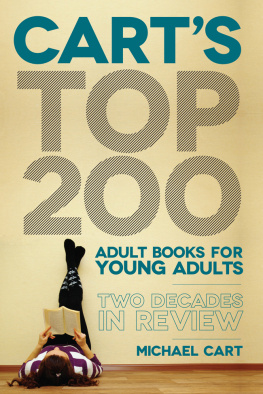Crossover Readers Advisory
Maximize Your Collection to Meet Reader Satisfaction
JESSICA E. MOYER, EDITOR

Copyright 2017 by ABC-CLIO, LLC
All rights reserved. No part of this publication may be reproduced, stored in a retrieval system, or transmitted, in any form or by any means, electronic, mechanical, photocopying, recording, or otherwise, except for the inclusion of brief quotations in a review, without prior permission in writing from the publisher.
Crossover Readers Advisory
Library of Congress Control Number:
2016954759
ISBN: 9781440838460
EISBN: 9781440838477
21 20 19 18 171 2 3 4 5
This book is also available as an eBook.
Libraries Unlimited
An Imprint of ABC-CLIO, LLC
ABC-CLIO, LLC
130 Cremona Drive, P.O. Box 1911
Santa Barbara, California 93116-1911
www.abc-clio.com
This book is printed on acid-free paper 
Manufactured in the United States of America
Contents
Jessica E. Moyer
Ann Chambers Theis
Jessica E. Moyer
Jessica E. Moyer
Kelly Fann
Kristi Chadwick
Ilene Appelbaum Lefkowitz and C.L. Quillen
Elizabeth Burns and Kelly Jensen
Jennifer Haas Thiele
Erin Downey Howerton
Alicia Ahlvers
Alicia Ahlvers
Lucy M. Lockley
Mary Wepking
Anna Grace Mickelsen
Introduction
Jessica E. Moyer
If someone told you that you could better meet reader needs without adding new titles to your collection, what would you say? This book asserts just that and shows you how to do it.
It is fairly well known among librarians that many adults enjoy what publishers have designated as Young Adult Fiction; and likewise, that many teens enjoy reading adult fiction and nonfiction. Many teens, especially those who read genre fiction, begin reading adult-designated titles and authors, and too often librarians do not know how to help. For example, in a recent roundtable discussion, science fiction and fantasy authors listed the books that started their love of the genre and adult authors like Anne McCaffrey, Robert Heinlein, Mercedes Lackey, and Ursula Le Guin were mentioned multiple times as favorite teen reads.
At the same time, the number of adults who are reading and enjoying YA titles is growing every year and constitutes an important part of the YA book market.
At the 2010 PLA Conference, I led a popular session on crossover advisory, available to both physical and virtual conference attendees. By the level of interest from librarians who attended the conference, as well as from those who contacted me after the conference, I realized there was a gap in the professional literature and a need for a guide to this body of literature. Conversations with librarian colleagues over the next few years reinforced the need for a resource, and I also experienced a groundswell of interest in contributing to such a volume.
Which titles can the readers advisor confidently recommend to these two audiences without risking a turn-off? This book takes the guesswork out of crossover readers advisory, employing the knowledge of expert readers advisors from both adult and teen services. Designed to fill a gap in the existing professional development literature on readers advisory services and genre titles, it offers a valuable approach. Many readers advisory guides include YA notes, but these are not always searchable or easy to find. Although Booklist Online includes YA notes for many of its adult book reviews that requires a subscription and the ability to search and select from hundreds of reviews. This guide offers a more concise and focused approach and is designed to be used by the busy librarians. Focusing exclusively on titles and authors that have strong appeal outside of their publisher-ordained readership, this book is meant to help the many teen readers who read adult books, and the many adult readers who enjoy YA titles.
Scope and Organization
Each chapter in this volume is dedicated to a single genre. Part I focuses on adult books for teen readers, while Part II covers teen books for adult readers. Many genres are covered in both parts (i.e., science fiction, fantasy, and romance), while others appear in just one section (i.e., thrillers, graphic novels, and new adult) as a result of their appeal and popularity to the targeted age group. Each chapter is also divided into two parts. In the first narrative section, you will find genre definitions, tips on working with readers, lists of tools and resources, and collection development advice. The second part of each chapter provides an annotated list of suggested titles in three major subareas of each genre, with descriptive annotations focusing on appeals and crossover concerns. Classic titles and authors are mentioned, but the focus is on recent and in-print titles that reflect the most recent developments and trends.
Conclusion
By covering a variety of genres that have specific appeal to this crossover readership, including general guidance and suggestions of specific titles and authors, this book is designed to meet the needs of public services staff who work with teen or adult populations. It will be useful for public librarians who work with both adult and teen services populations, as well as school librarians who may need to suggest adult titles to their leisure readers (see the popularity of School Library Journals Adult Books for Teens blog) as well as suggest YA titles to their teacher colleagues. Above all, this is a guide for readers and those who want to help readers of all ages find their next great read.
.
.
.
.
.
PART I
Adult Books for Teens
1
Mystery and Detection
Ann Chambers Theis
Introduction to the Genre
Definition
Mystery and detection is a form of narrative fiction using a structured plot focused on investigation and crime solving. The emphasis is on who, how, and why dunit, the detection process, and the resolution. These imaginative stories often involve suspense and intrigue as well as solving crimes. Series are popular in this genre, and detectives, secondary characters, and sidekicks are absorbing creations that engage readers.
Mystery and detection is a part of a large and diverse category of crime fiction that also includes thrillers as well as the subgenres of legal, technological, and espionage. Many espionage, legal, and thriller stories are included in the adrenalin chapter by Jennifer Haas Thiele. Within mystery and detection are numerous subgenres including traditional, female sleuths, hard-boiled, international crime, historical, police procedurals, and private eyes.
Appeals
The clear focus of this genre is the cerebral puzzle component. The pleasure of unraveling the mystery provides a satisfying conclusion for readers. Mystery and detection books may also appeal to our desire for order and justice, which may be of particular interest to teen readers. These books provide intellectual enjoyment and opportunities to learn about other cultures, locations, and the past as well as explore social and political issues and cultural concerns. While the overall emphasis is on the intellectual aspects of solving crime, key characters are often an important draw in engaging readers, resulting in numerous successful series. Tone and pacing are important since the mystery and detection genre is an amalgamation of many diverse subgenres. Like all good reads, the power of a good story, well paced and well told, is a crucial factor in the enjoyment of this genre.



